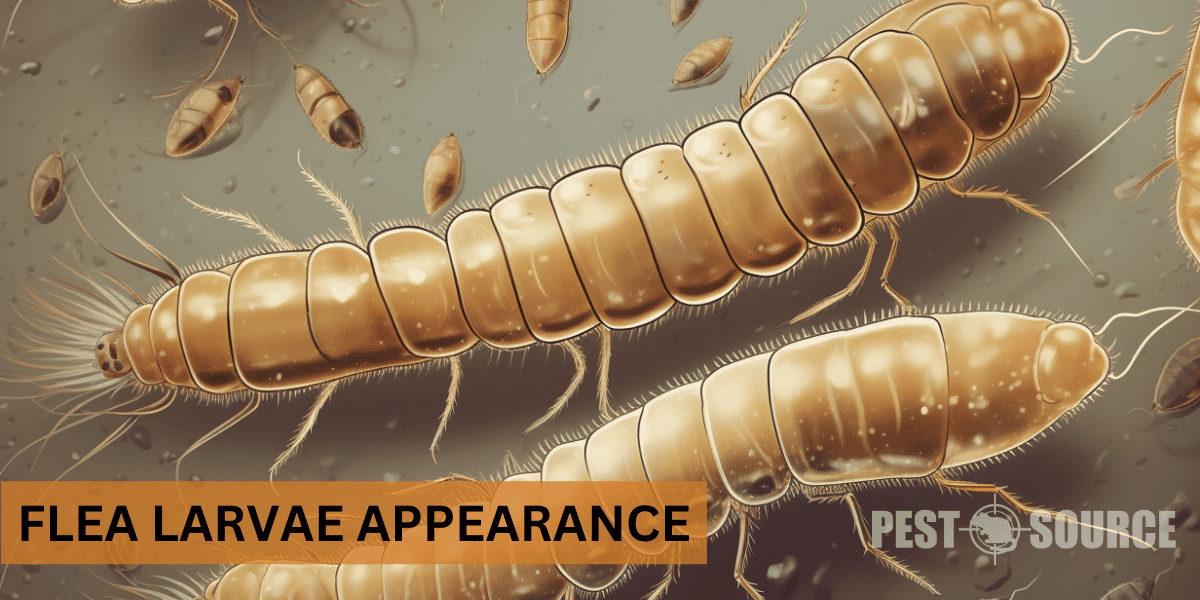Fleas are a common nuisance for pet owners and can quickly infest a home if not detected and dealt with promptly. Understanding each stage of a flea’s life cycle, especially the appearance of flea eggs and larvae, is crucial in identifying and eradicating these pests.
This comprehensive guide to understanding flea larvae provides in-depth information on the life cycle, appearance, and various stages of fleas, which are essential to help pet owners and households keep these pesky invaders at bay. Knowing more about flea larvae and their appearance gives you a leg up in your efforts to identify, control, and prevent flea infestations.
POINTS
- Flea larvae are worm-like, segmented creatures that darken as they mature, measuring between 1/8 and 1/4 inch in length. They are the second stage of the flea life cycle, following the egg stage.
- Flea eggs are small (about 0.5mm in length), oval-shaped, pearly white, and when in pets’ environments, they can appear as tiny specks against fur or as accumulations in bedding and carpets.
- Understanding the various stages of the flea life cycle, including eggs, larvae, pupae, and adult fleas, is crucial for effective pest control, enabling you to identify infestations and eliminate them effectively.
- Flea larvae primarily feed on flea dirt, which is the feces and digested blood left behind by adult fleas. This nutrition source helps them grow and develop into the pupal stage.
- Knowing the differences in appearance among various flea species, such as cat fleas and sand fleas, assists in tailoring your approach to flea control and ensuring effective identification and treatment.
Understanding Fleas and Their Life Cycle
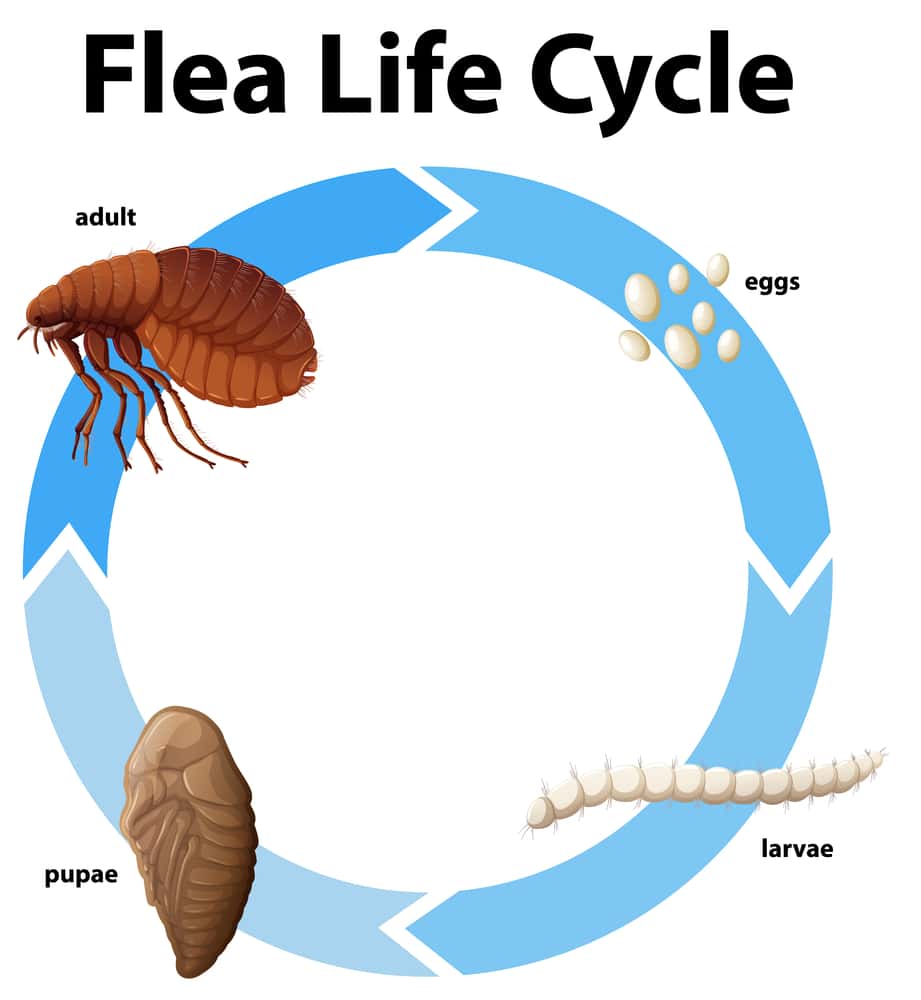
Understanding the life cycle of fleas is crucial for effectively managing and preventing infestations in your home and on your pets. Below are key highlights of each stage in the flea life cycle, providing essential insights for targeted pest control efforts:
| Life Cycle Stage | Description | Size | Duration |
|---|---|---|---|
| Eggs | Small, oval-shaped, pearly white eggs laid by adult fleas on the host or in the host’s environment. They can appear as tiny specks against fur or accumulate in bedding and carpets. | About 0.5mm | 1-10 days |
| Larvae | Worm-like, segmented creatures that feed on organic debris and flea dirt. They darken as they mature. | 1/8 to 1/4 inch | 5-20 days |
| Pupae | Fleas develop inside a cocoon in the environment, becoming adult fleas. | Not Applicable | 5 days to 1 year |
| Adult Fleas | Small, oval-shaped, pearly white eggs are laid by adult fleas on the host or in the host’s environment. They can appear as tiny specks against fur or accumulate in bedding and carpets. | About 1/8 inch | Up to 100 days |
What is Flea Larvae?
Flea larvae are the second stage in the life cycle of a flea, following the egg stage. They are small, worm-like creatures that undergo metamorphosis to become pupae and eventually adult fleas. Identifying flea larvae is key to understanding and controlling flea infestations in your home or on your pets.
Why is Understanding Flea Life Cycle Important?
Knowing the various stages of the flea life cycle is crucial for effective pest control. By understanding what flea larvae, as well as eggs, pupae, and adult fleas look like, you can more easily identify infestations and take the necessary steps to eliminate them. Additionally, certain pest control methods are more effective during specific stages of the flea life cycle, so understanding the life cycle allows you to target your treatment plan for maximum efficacy.
Comprehensive Overview of Flea Life Cycle
What Does a Baby Flea Look Like?
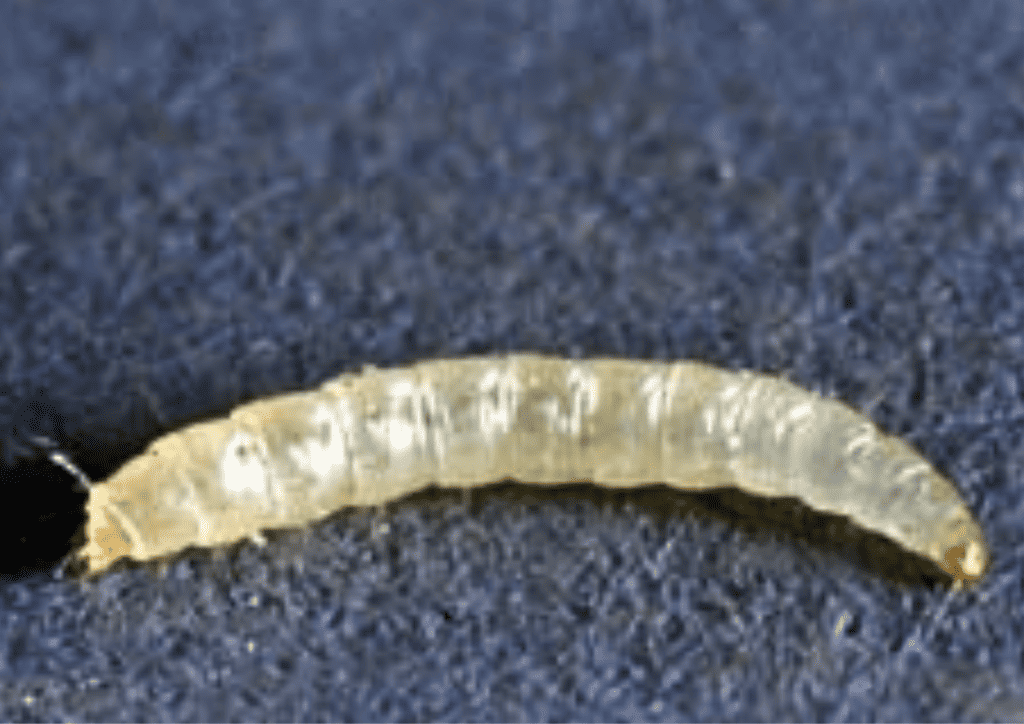
A baby flea, also known as a larva, appears as a tiny, white, worm-like creature. At the youngest stage, these larvae are almost transparent and can be as small as 1/16 of an inch long. As they grow, they become more visible and pigmented, ranging from white to darker shades of brown.
How Do Baby Fleas Look Like as They Grow?
As flea larvae grow, they gradually become darker in color due to the consumption of their primary food source – flea dirt, which is essentially dried blood and feces from adult fleas. At full size, flea larvae measure between 1/8 and 1/4 inch long, and their appearance becomes segmented, resembling a miniature caterpillar.
What Do Fleas Look Like When They Hatch?
When flea larvae hatch from their eggs, they are nearly transparent, elongated, and have very few distinguishing features. As they mature, their bodies develop segmentation and bristles, making them appear more worm-like. It’s important to note that these newly hatched flea larvae are mobile and may be challenging to spot due to their small size and pale coloration.
Detailed Examination of Flea Eggs
A detailed examination of flea eggs is vital for identifying and managing flea infestations effectively. By understanding the characteristics of flea eggs, such as their appearance, size, and typical locations, you can take proactive steps to eliminate these pests from your environment. Here’s a table summarizing key aspects of flea eggs:
| Characteristic | Description |
|---|---|
| Appearance | Tiny, oval-shaped, and pearly white |
| Size | Approximately 0.5mm in length |
| Visibility | Can be seen with the naked eye, especially on darker surfaces |
| Common Locations | Often found in pets’ environments, such as bedding and carpets |
What Do Flea Eggs Look Like?
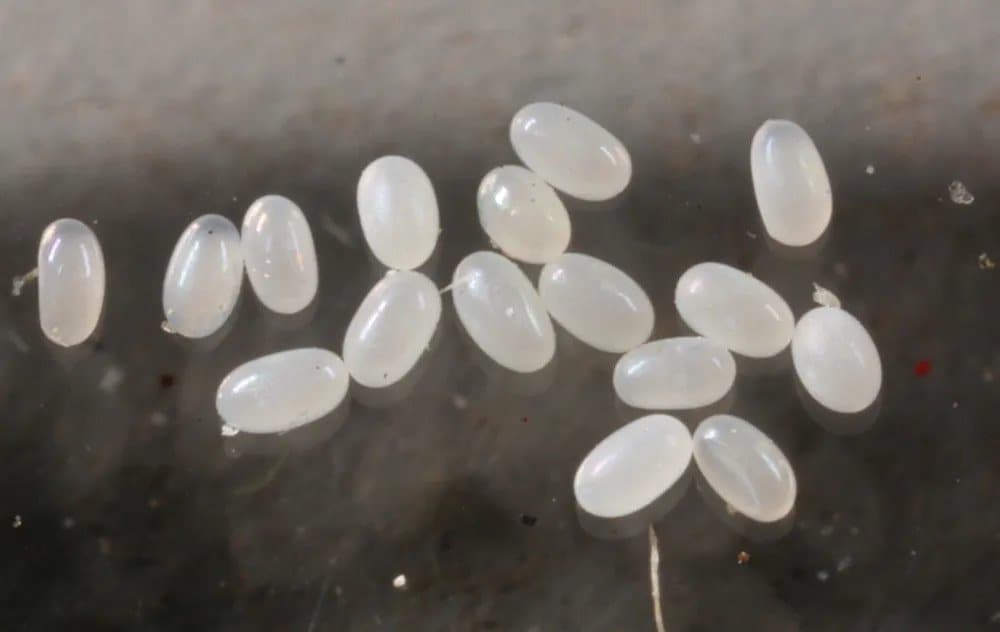
Flea eggs are tiny, oval-shaped, and pearly white in color. They are smooth and dry, which allows them to easily fall off the host animal and spread the infestation to other parts of the home.
How Big are Flea Eggs?
Flea eggs are incredibly small, measuring only about 0.5mm in length. Because of their minuscule size, they can often be mistaken for grains of salt or specks of dust.
What Color are Flea Eggs?
Flea eggs are usually white or off-white in color, which makes them difficult to spot against light-colored fur or fabrics. However, if you find them on a darker surface, they may stand out due to their pale appearance.
Are Flea Eggs Hard or Soft?
Flea eggs are relatively soft and fragile, which makes them susceptible to damage during the cleaning process. Vacuuming, brushing, or washing surfaces can help remove and break the flea eggs, preventing the continuation of the life cycle.
Can You See Flea Eggs with Naked Eye?

Although flea eggs are small, they can be seen with the naked eye if you know what to look for. Their pale color and oval shape make them distinguishable if you spot them on darker surfaces or in large clusters. However, due to their minute size, a magnifying glass or microscope may be necessary for detailed examination.
What Do Flea Eggs Look Like on Cats and Dogs?
On pets, flea eggs may appear as small white specks, especially against darker fur. They can often be found around the neck, ears, and tail. Flea eggs may also accumulate in the pet’s bedding, on the floor, or on furniture where your pet often rests.
Thorough Analysis of Flea Larvae
Flea larvae are a crucial stage in the life cycle of fleas, and understanding their characteristics can significantly aid in controlling flea populations. Below is a table that outlines the key characteristics of flea larvae:
| Characteristic | Description |
|---|---|
| Appearance | Elongated, worm-like, with a whitish body that darkens with maturity. Covered in fine hairs for a bristled appearance. |
| Growth Stages | Starts nearly transparent, becomes darker as it consumes flea dirt. |
| Length | Ranges from 1/8 to 1/4 inch when fully grown. |
| Color | Transitions from nearly transparent to shades of brown. |
| Environment | Preferably found in dark, moist areas with access to flea dirt (food source). |
What Does Flea Larvae Look Like?

Flea larvae have an elongated, worm-like appearance with a whitish body that becomes darker as they mature. The body is segmented and covered in fine hairs, giving them a bristled appearance. At full size, their length ranges from 1/8 to 1/4 inch.
What Does Flea Larva Look Like?
A single flea larva looks the same as described above for flea larvae. It also resembles a small caterpillar, with a segmented and bristled body that grows darker in color as it matures.
How Big are Flea Larvae?
Flea larvae typically reach a length of 1/8 to 1/4 inch when they are fully grown. The duration of their larval stage can vary based on factors such as temperature and food availability, which can influence their size and developmental rate.
What Color are Flea Larvae?
Flea larvae start off as nearly transparent but gradually darken as they consume flea dirt. Their color will range from white to shades of brown as they grow and mature.
What Do Flea Larvae Look Like on Cats and Dogs?
Flea larvae can usually be found among your pet’s fur, though they do not attach themselves to the skin like adult fleas do. They may appear as small, bristled, worm-like creatures nestled in the pet’s fur, often near the base of the tail, behind the ears, or on the neck. However, most flea larvae will be found in the pet’s environment, such as bedding, carpets, and upholstery, where flea dirt is more abundant.
Other Stages in the Flea Life Cycle
The flea life cycle includes several stages beyond just eggs and larvae, specifically the pupae and adult stages, each with distinct characteristics and behaviors. Here’s a table that details the pupae and adult stages of the flea life cycle:
| Life Cycle Stage | Description | Environment/Habitat |
|---|---|---|
| Pupae | Fleas develop inside a cocoon, undergoing metamorphosis into adults. Cocoon can be covered in debris to blend with the environment. | Typically found in protected, undisturbed areas like deep carpet fibers or under furniture. |
| Adult Fleas | Small, wingless insects with a strong propensity for jumping. Feed on the blood of their host. | Live on hosts or in close proximity to their resting areas, such as pet bedding or upholstered furniture. |
What Do Flea Pupae Look Like?
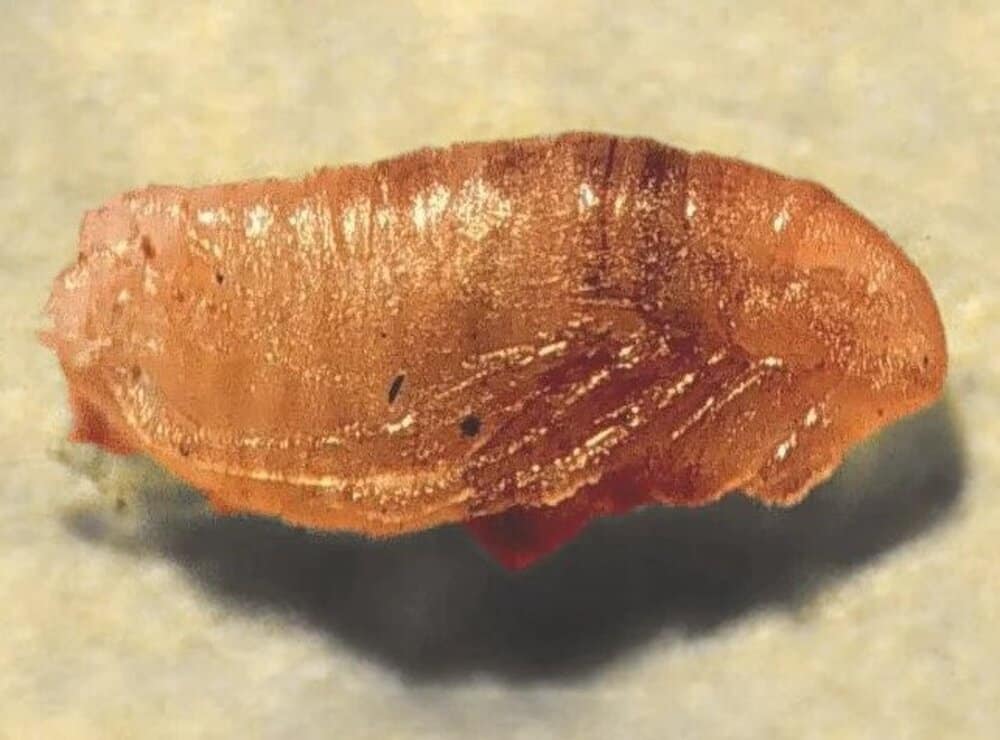
Flea pupae are the third stage in the life cycle, following the larval stage. They form a protective silk cocoon that appears brownish and can be covered in debris from the pet’s environment, which helps them blend in with their surroundings. Inside the cocoon, the pupa transforms into an adult flea.
What Does a Flea Cocoon Look Like?

A flea cocoon looks like a small, oval-shaped, brown casing about 1/16 inch long. The cocoon can be difficult to spot due to its protective debris coating, which helps it blend in with its environment. The flea remains within the cocoon during its pupal stage until it is ready to emerge as an adult flea.
What Do Adult Fleas Look Like?
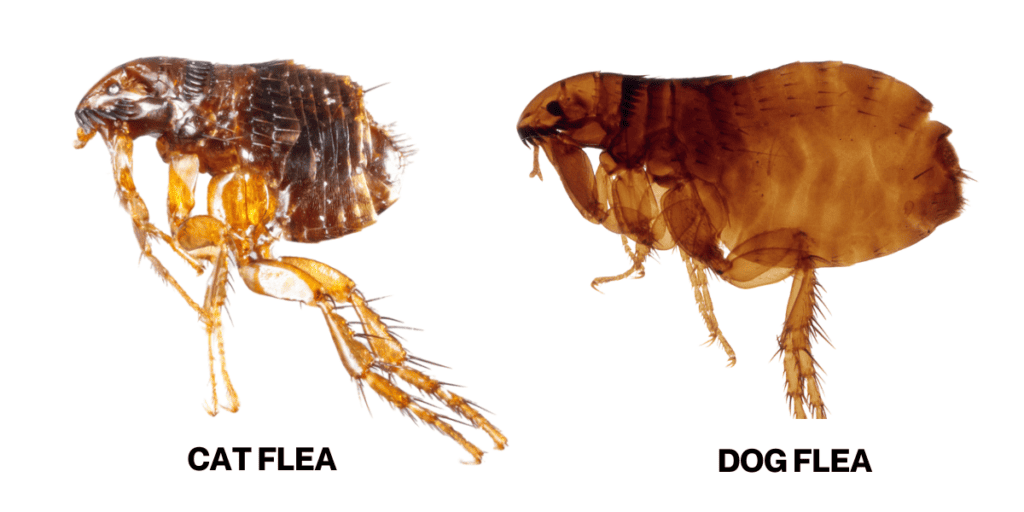
Adult fleas are small, wingless insects with a flattened, dark brown or reddish-brown body. They measure about 1/8 inch long and have six long legs, with their hind legs being much larger and adapted for jumping. Fleas also have specialized mouthparts that enable them to pierce the skin and feed on the blood of their host.
Additional Questions Related to Fleas
What Does a Flea Look Like Up Close?
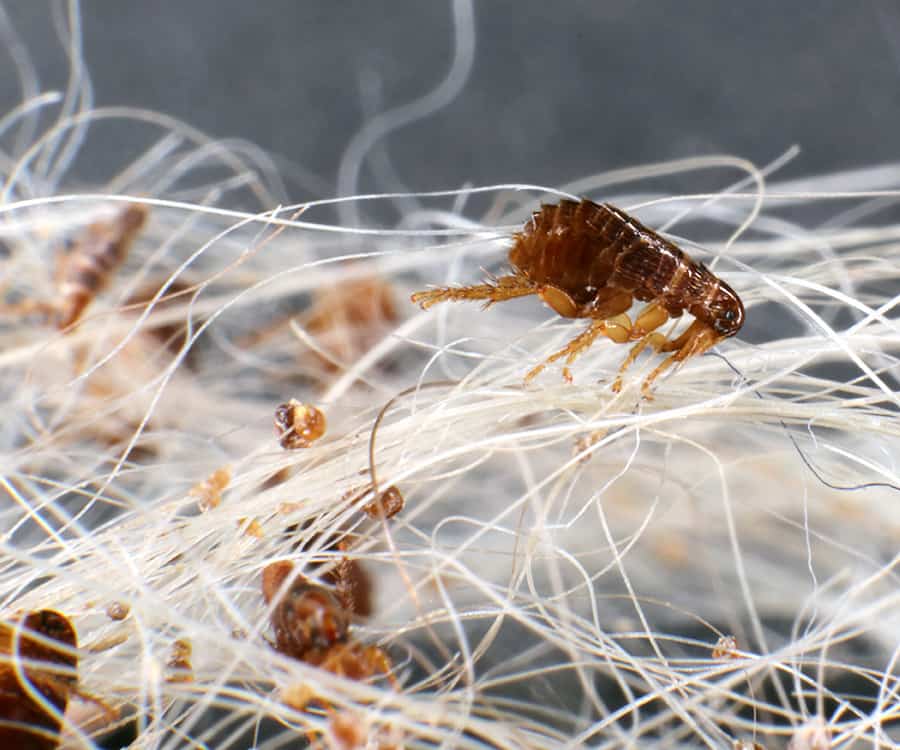
Under magnification, a flea’s dark brown or reddish-brown body is more apparent, along with its six long legs, large hind legs, and mouthparts designed for piercing and sucking. Fleas covered in microscopic hairs and their bodies are flattened, which helps them navigate through your pet’s fur efficiently.
What Color are Fleas?
Fleas range in color from dark brown to reddish-brown. The color may vary slightly depending on the species and how recently they have fed on their host’s blood, but they are generally within this color spectrum.
How Tiny or Big are Fleas?
Fleas are quite small, typically measuring only about 1/8 inch long. Although they are relatively tiny insects, their powerful hind legs allow them to jump up to 150 times their body length, making them highly mobile pests.
What Does a Flea Nest Look Like?
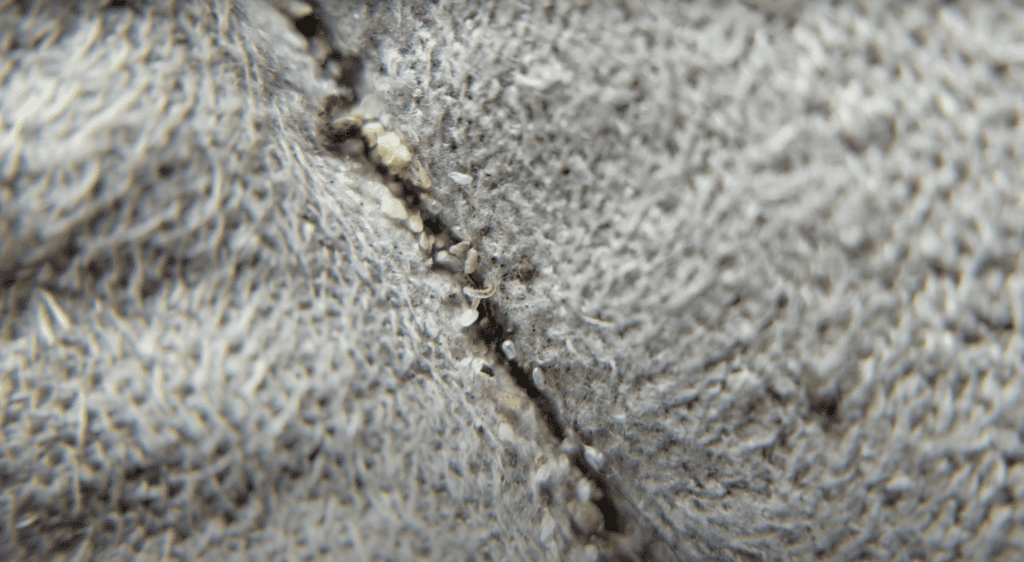
Fleas do not create nests in the traditional sense. However, flea eggs and larvae can accumulate in specific areas where your pet frequently rests, such as bedding, carpets, and upholstery. These areas can also be referred to as “hotspots” or breeding grounds for fleas.
What Do Flea Eggs and Larvae Look Like?
Flea eggs are small, oval, and white, resembling tiny grains of salt. Flea larvae appear as elongated, worm-like creatures with a segmented body and bristled appearance due to fine hairs along their sides.
What Do Flea Eggs and Larvae Look Like on a Cat?
Flea eggs may show as tiny white specks against the cat’s fur, while flea larvae can appear as small, worm-like creatures nestled close to the cat’s skin, although they are more commonly found in the pet’s environment. Areas like the base of the tail, behind the ears, and on the neck are common locations to find flea eggs and larvae on a cat.
Unique Characteristics of Flea Types
What Do Cat Flea Eggs Look Like?

Cat flea eggs look similar to those of other flea species. They are small, oval-shaped, and white in color, resembling tiny grains of salt. They are typically found on the cat’s fur or in its environment, such as bedding or carpet.
What Do Sand Flea Eggs Look Like?
Sand flea eggs are similar in appearance to other flea eggs but may be slightly larger in size. They are tiny, oval, and pale, usually found buried in sandy environments, which serve as their primary habitat.
What Does Flea Dirt Look Like?
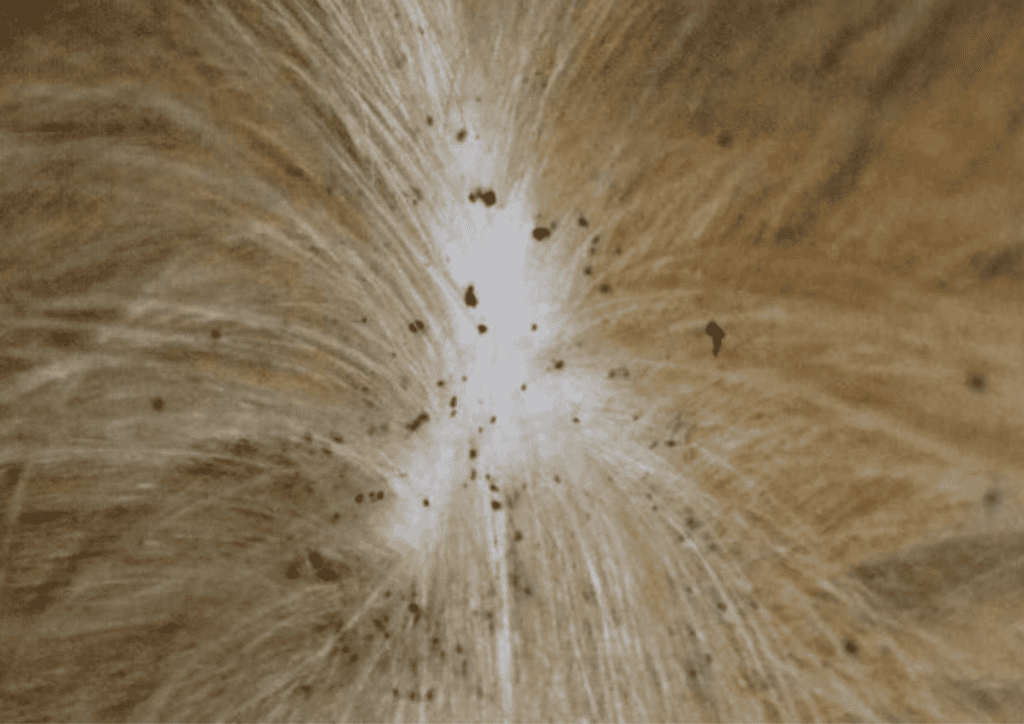
Flea dirt is the feces of adult fleas, which consists of digested blood from the host animal. It appears as small, dark, pepper-like specks and can be found on your pet’s skin or fur or in areas where your pet spends time, such as bedding or furniture.
Unusual Manifestations of Flea Infestation
What Do Dead Flea Eggs Look Like?
Dead flea eggs may be more challenging to identify compared to live ones. They resemble live eggs in size and shape, but their color may appear slightly darker or somewhat discolored. Over time, dead eggs may dry out and collapse, making them even more difficult to detect.
What Do Flea Worms Look Like?
The term ‘flea worms’ is a misconception, as these are actually flea larvae. As mentioned before, they are small, worm-like, and initially almost transparent but darken as they grow and consume flea dirt. They have a segmented, bristled appearance and measure between 1/8 and 1/4 inch in length.
Flea Maggots: What Are They?
Flea maggots is another incorrect term often used to describe flea larvae. The name can lead to confusion but refers to the same worm-like, segmented creatures that are the second stage of the flea life cycle.
Nutrition and Survival of Flea Larvae
What Do Flea Larvae Eat?
The nutrition and survival of flea larvae are pivotal factors in the flea life cycle, influencing their growth and development into pupae and eventually adult fleas. Understanding what flea larvae eat and how they thrive can significantly aid in controlling and preventing flea infestations. Here’s what you need to know:
- Primary Diet: Flea larvae primarily feed on flea dirt, which is the digested blood and feces left behind by adult fleas. This provides them with the essential nutrients needed for growth.
- Additional Sources: Besides flea dirt, larvae may consume other organic debris found in their environment, such as shed skin cells or decaying material. This can supplement their diet and support their development.
- Environmental Impact: The presence of flea larvae and their food sources highlights the importance of cleanliness. Regular vacuuming, washing of pet bedding, and thorough cleaning of pet areas can disrupt the life cycle and reduce infestation risks.
By targeting the dietary needs and environmental conditions favorable to flea larvae, one can implement effective strategies to disrupt their development and reduce the likelihood of a flea population establishing itself.
Conclusion
Importance of Knowledge on Flea Appearance and Life Cycle in Flea Control
Understanding the appearance of fleas at different stages of their life cycle ensures prompt identification of infestations, allowing for targeted control efforts. Certain flea control methods are more effective at specific life cycle stages, so knowing these details helps optimize your approach to flea control for better results. Additionally, having this knowledge enables pet owners to monitor and maintain their pets’ health effectively.

